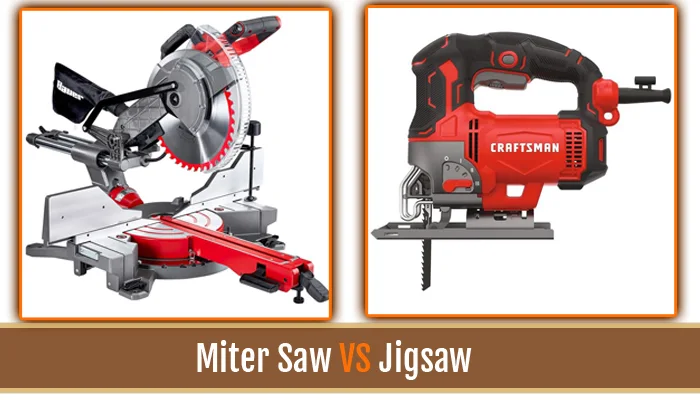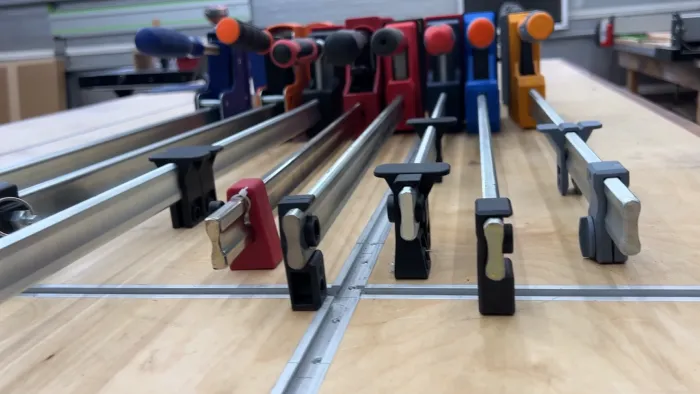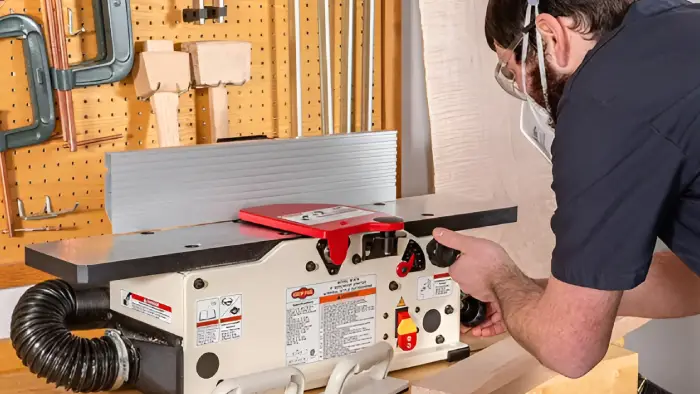WoodenuKnow.com is a participant in the Amazon Services LLC Associates Program, an affiliate advertising program designed to provide a means for sites to earn advertising fees by advertising and linking to Amazon.com and may earn from qualifying purchases.
Regarding woodworking, two of the essential tools are a jigsaw and a miter saw. Both saws have unique capabilities, and the best choice for your project depends on several factors.
A miter saw is a carpentry tool used to make precise cuts at various angles. It can be used to cut molding, trim, and other materials for projects such as framing, cabinetry, and decorative work. The miter saw blade is mounted on a swinging arm that allows it to pivot left or right to create the desired angle. The arm also tilts to create beveled cuts.
You can use a jigsaw for cutting various materials, including wood, plastic, and metal. Jigsaws typically have a reciprocating blade that cuts on the up and down strokes. Some jigsaws also have orbital action, which means that the blade moves in a circular motion and up and down. This type of saw is ideal for making curved or circular cuts.
Here are some things to consider when deciding between miter saw vs jigsaw:
Miter Saw vs Jigsaw: Different Types
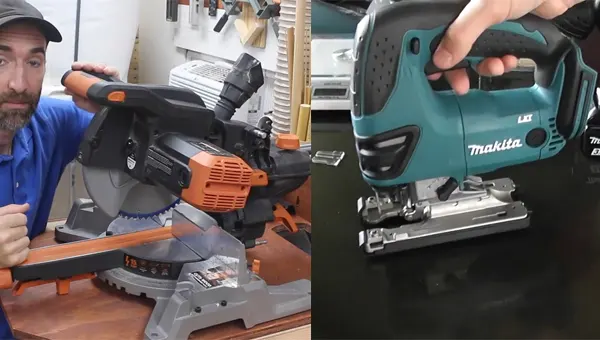
Different Types of Miter Saws
Miter saws come in a variety of sizes and styles, each designed for a specific purpose.
Standard Miter Saw: The most common type of miter saw is the standard miter saw, which is ideal for making cuts in wood molding and trim.
Compound Miter Saw: A compound miter saw is similar to a standard miter saw, but it can also perform bevel cuts, making it a versatile tool for both woodworking and carpentry projects.
Sliding Compound Miter Saw: A sliding compound miter saw has all the features of a compound miter saw, but it also includes a sliding arm that allows for longer cuts.
Chop Saw: A chop saw is a type of miter saw that is designed for making quick, clean cuts in metal or stone. No matter what your needs, there is a miter saw that’s perfect for the job.
Different Types of Miter Saws
There are several different types of jigsaws on the market, each with its own strengths and weaknesses. The most popular type of jigsaw is the corded jigsaw, which is powerful and relatively inexpensive.
Corded jigsaws are limited by their power; the jigsaw type can be a nuisance when working in tight spaces. Jigsaws are more expensive but offer the convenience of being able to work without being tethered to a power outlet.
Another type of jigsaw is the pendulum jigsaw, which is designed for making quick, rough cuts. Pendulum jigsaws are not as precise as other types of jigsaws but can be helpful for quickly cutting through thick materials.
Jigsaw vs Miter Saw: Benefits Of Them
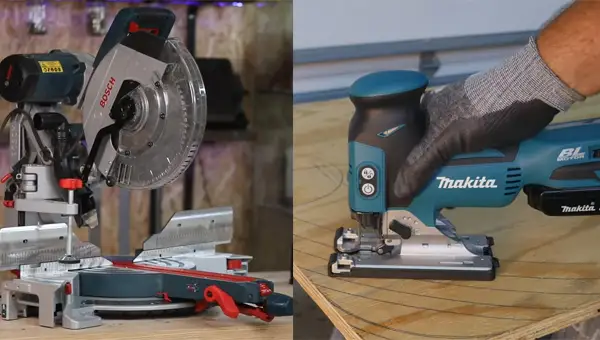
Benefits Of Using A Miter Saw
Adding a miter saw to your workshop can be a great addition to any workshop. Here are just a few of the many advantages of using a miter saw:
- Accuracy: Miter saws are designed for making precise cuts. This is thanks to the fact that they have a guide that helps to keep the blade in a straight line as you cut. This is ideal when it comes to trimming door frames and window frames.
- Versatility: Miter saws can be used for a variety of tasks such as cutting molding, baseboards, and picture frames. Some miter saws even come with special features that allow you to make more complex cuts.
- Speed: Miter saws can help you to complete tasks quickly thanks to their speed and efficiency. This is especially useful if you have a large project that needs to be completed in a short amount of time.
- Safety: Miter saws are relatively safe to use thanks to their design. The blade is hidden away from view, which helps to prevent accidents. Most miter saws have a safety switch that must be engaged before the saw can be turned on.
- Easy to use: Miter saws are relatively straightforward, even for novice do-it-yourselfers. With a bit of practice, you’ll be able to make perfect cuts every time.
- Time-saving: A miter saw can significantly save a lot of time when cutting by hand.
Benefits Of Using A Jigsaw
A jigsaw is a powerful tool that can be used for various applications, from cutting through thick pieces of wood to making detailed cuts in thinner materials.
Jigsaws are relatively easy to use and offer many advantages over other power saws, making them a popular choice for hobbyists and professionals. Some of the key benefits of using a jigsaw include:
- More significant control over the cut: because you guide the blade with your hand, you have more control over the direction of the cut than you would with a circular saw, for example. This is especially useful when working with irregularly shaped pieces or when following a curved line;
- Ability to make intricate cuts: due to their small size and maneuverability, jigsaws can be used to make very detailed and intricate cuts that would be difficult or impossible to achieve with a larger saw.
Miter Saw vs Jigsaw: Drawbacks Of Them
The Drawbacks Of Using A Miter Saw.
There are some drawbacks to using a miter saw, even though it can make precise cuts.
- Miter saws can be difficult to set up, and they require a level surface to work properly.
- They can be dangerous to use if you’re not careful. The blade is very sharp, and it’s easy to get your fingers caught in it if you’re not paying attention.
- Miter saws can create a lot of dust, so it’s important to wear a respirator or dust mask when using one.
Overall, miter saws can be helpful tools, but it’s important to be aware of the potential dangers before using one.
The Drawbacks Of Using A Jigsaw.
- One of the biggest problems with jigsaws is that they can be very difficult to control. The blade constantly moves up and down at high speeds, making it easy for the saw to slip and cause accidents.
- Jig saws produce a lot of vibration, which can cause fatigue and numbness in the hands and arms.
Despite these drawbacks, jigsaws remain a popular choice for many woodworkers and homeowners due to their versatility and ease of use.
Miter Saw vs Jigsaw: Choosing According To Your Needs
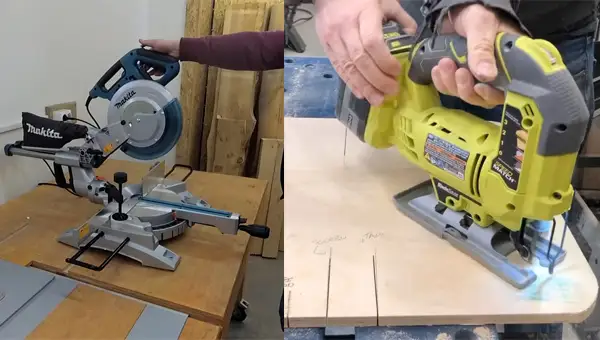
The Miter Saw
When it comes to finding the right miter saw for your needs, there are a few things you’ll want to keep in mind.
- Type of material you will be cutting most often. A standard miter saw will do the job fine if you primarily work with wood. If you plan to cut a lot of metal or stone, you will need a heavier-duty saw to handle the more rigid material.
- Decide what type of saw you need. If you primarily work with smaller pieces of wood, then a basic 10-inch miter saw should suffice. If you plan on working with larger pieces of lumber, you will need a 12-inch or larger saw.
- Size of the projects you’ll be working on. If you only cut small pieces, a smaller saw will be plenty powerful. But if you work on larger projects, you’ll need a saw with more power to get the job done.
- Consider the range of angles you will need to cut. A basic miter saw will be fine if you only need to make simple cuts. More complicated cuts need to choose a saw with a broader range of angles.
- You should think about the power of the saw. In case you will only be making occasional cuts, then an electric miter saw should be fine. If you use the saw frequently, you may want to invest in a gasoline-powered saw.
By keeping these factors in mind, you can be sure to find the perfect miter saw for your next project.
The JigSaw
When choosing a suitable jigsaw for a job, it’s essential to consider your needs to take it into account.
- The size of the projects you will work on. Think about the projects you’ll be working on. A basic jigsaw should suffice if you’re only doing light-duty work.
- Consider the type of power source you prefer. Jigsaws can be either corded or cordless, and each has advantages and disadvantages. Corded tools tend to be more powerful but tethered to an outlet, limiting your mobility.
- Take into account the features that are important to you. Some models come with built-in laser guides for greater accuracy, while others have adjustable speed settings so you can tailor the tool to your specific needs.
By taking all of these factors into consideration, you can be sure to choose the suitable jigsaw for your needs.
Miter Saw vs Jigsaw: Some Common Mistakes
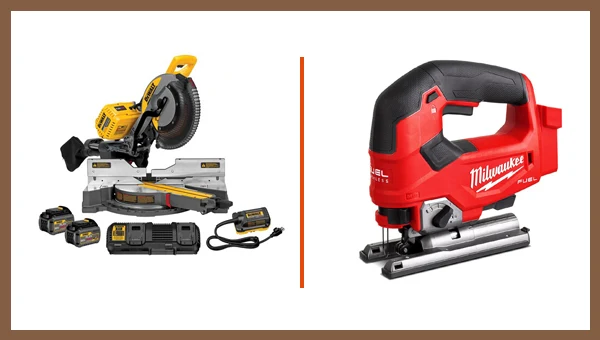
The Miter Saw Mistakes
A miter saw is a handy tool that can be used to make quick, accurate cuts. However, using the saw correctly is essential to avoid dangerous kickbacks and inaccurate cuts. Some mistakes people make with a miter saw are:
- One common mistake is not setting the blade to the correct angle. The blade must be set at a perfect angle to make precise cuts. Measure wood correctly before cutting. Hold the workpiece firmly in place.
- Measuring the wood twice before cutting is essential to ensure it is the correct size. Many people are unaware that the miter saw can only make cuts at certain angles, leading to inaccuracies in the final product. People mistakenly try to cut too quickly, resulting in uneven or inaccurate cuts.
- Always use push sticks or other safety devices when operating a miter saw, as this can help prevent serious injuries. The blade should be parallel to the edge of the workpiece and positioned so that it will cut through the center of the piece.
- People often forget to account for the kerf or width of the cut made by the saw blade. The kerf must be considered when making measurements, or the finished piece will be too small.
- Not securing and supporting the workpiece properly can also lead to kickback and the workpiece being ejected from the saw. The workpiece should be firmly held in place before beginning the cut to the table or fence and not move during the cutting process, and it should be supported at both ends to prevent it from tipping or binding during the cut.
- Another common mistake is not using the proper blade for cutting material. When cutting hardwoods, a blade with more teeth will produce a smoother cut than a blade with fewer teeth.
- People often mistake using too much force when cutting. While it is important to apply enough pressure to keep the workpiece from moving, applying too much pressure can cause the blade to bind in the workpiece, resulting in an inaccurate cut.
- Another common mistake when using a miter saw is not making the blade sharp and not securing the workpiece properly. Not making sure the blade is sharp can lead to the blade binding in the cut, which can kick the workpiece back at the operator or cause the blade to break.
- Ensure you set the blade depth, so it cuts only through the workpiece and not the table or other surface below.
- Clamping the workpiece firmly before cutting is essential to prevent it from shifting or moving during the cutting process.
The JigSaw Mistakes
Jig saws are versatile tools for various tasks, from cutting curves in wood to making intricate designs in metal.
- One of the most common mistakes people make when using a jig saw is failing to secure the workpiece. If the workpiece is not securely clamped down, it can slip or move while you are cutting, which can lead to serious injury.
- Another common mistake is using the wrong blade for cutting material. An improperly sized blade can cause it to break, while using a blade that is too thick can make it difficult to control the saw and lead to inaccurate cuts.
- People often mistake using a jigsaw without first measuring and marking their cut. This can lead to inaccurate cuts and wasted material.
- Different materials require different blades, and using the wrong blade can damage both the material and the jigsaw itself.
- They may ignore the direction of the blade when making cuts. This can cause the cut to be uneven or jagged.
- People sometimes force the jigsaw through the material, resulting in uneven or jagged edges. The key to a successful cut is using a jigsaw to do the work.
- Jig saw blades come in various sizes and shapes, each designed for a specific type of material. Using the wrong blade will not only make the cut more difficult, but it can also damage the workpiece or cause the jigsaw to overheat.
Safety Steps
When using a miter saw, it is vital to take all these precautions to ensure a safe and successful cut.
Safety Glasses: People often forget to use safety glasses when using a miter saw. The blades on a miter saw can spin at a very high rate of speed and can easily cause severe injuries if they come into contact with skin or eyes. Wearing safety glasses will help to protect you from these potential injuries.
Ear Protection: Keep your ears protected from flying debris and loud noises when using a miter saw by wearing earplugs or earmuffs.
Some Other Types of Saw
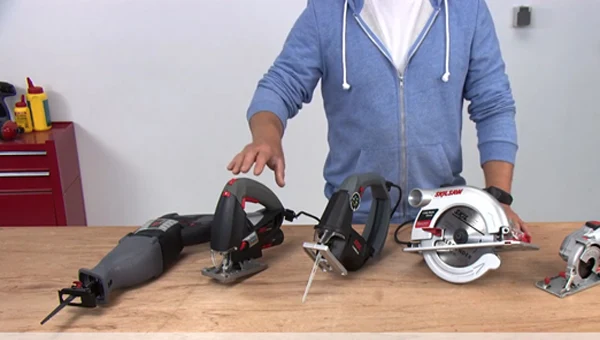
If you are looking for answers to some of the most frequently asked questions about miter saws and jigsaws, you have come to the right place. This section will look at key differences between these two types of saws to decide which is suitable for your next project. So, without further ado, let’s get started.
Compound Miter Saw
A compound miter saw is a type of power tool that is commonly used for cutting wood. It consists of a circular blade mounted on a swing arm, which can be adjusted to make horizontal and vertical cuts.
Compound miter saws are often used by carpenters and woodworkers, as they can make precise cuts. DIY enthusiasts and homeowners can also use them for tasks such as trimming door frames and crown molding.
When shopping for a compound miter saw, it is essential to consider the types of cuts you will be making, as well as the size of the blade. Some models also come with features such as laser guides, which can help make long or complex cuts.
Band Saw
A band saw is a powerful woodworking tool that can make various cuts, including straight, curved, and scroll cuts. While a band saw can be operated by hand, most woodworkers prefer to use a power model for greater accuracy and efficiency.
When shopping for a band saw, it is essential to pay attention to the size of the blade as well as the horsepower of the motor. You should also consider the cuts you will make and whether you need a machine with unique features such as adjustable speed or laser guidance.
With so many market options, finding the right band saw for your needs can be tricky. Taking the time to do your research will pay off in the long run by helping you find a saw that can tackle any project.
Circular Saws
A circular saw is a power saw that uses a blade to cut through materials. It is one of the most versatile tools in a woodworker’s arsenal, making straight and curved cuts. While there are many types of circular saws on the market, they all share several standard features.
Most have a circular blade mounted on an arbor, which is attached to a motor. The motor powers the blade, spinning it at high speeds. The operator controls the cut’s depth and angle by adjusting the blade’s position relative to the workpiece. A circular saw can quickly work even the toughest lumber when appropriately used.
Table Saw
A table saw is commonly used by woodworkers and carpenters. Circular blades are mounted on an arbor and driven by an electric motor. The blade is exposed along the top of the table, and the operator uses a rip fence to guide the workpiece through the blade.
There are many variations of table saws, which are available in different sizes and configurations and can be used to make a wide range of cuts, including rip cuts, crosscuts, and dadoes. A table saw can be highly versatile and powerful when appropriately used.
Because the blade is exposed, there is a risk of serious injury if the operator is not careful. It is essential to always use proper guarding and to follow all safety guidelines when using a table saw.
Scroll Saw
A scroll saw is a type of saw that is used to create intricate designs in wood. This saw has a small, thin blade mounted on a scroll-shaped arm. The arm is attached to a table, and the blade is moved up and down by a handle connected to the arm.
Scroll saws create detailed woodworking projects such as furniture, toys, and jewelry. They are also used to create detailed artwork on wood, metal, glass, and other materials. Scroll saws are available in various sizes and styles and can be operated manually or with a motor.
Reciprocating Saw
A reciprocating saw helps to make quick work of large cutting jobs. The saw uses a rapid back-and-forth motion to cut through materials, and its compact size makes it ideal for use in tight spaces. Reciprocating saws can cut through various materials, including wood, metal, and plastic.
When choosing a reciprocating saw, make sure you consider the blade’s size and the motor’s power. blade size will determine the maximum thickness of material that can be cut, while motor power will dictate the speed of the blade.
Track Saw
A track saw is an essential tool for anyone who does a lot of woodworking. The saw consists of a minor handheld saw mounted on a track. The track is usually made of metal or plastic, and it has a series of guide rails that keep the saw blade straight as it cuts through the wood.
This makes track saws ideal for cutting door jambs or trimming cabinet doors. When using a track saw, it is essential to use a sharp blade. Track saws are also relatively lightweight and portable, making them easily transported from one job site to another. Most track saws have a built-in dust collection system to help keep your work area clean.
Power Saw
A power saw is a handheld tool that uses a toothed blade to cut through materials such as wood, metal, or stone. Various types of power saws are available on the market, with each being created for a different purpose.
Power saws can be powered by either electricity or a battery, and they come in both corded and cordless models. Power saws can be either hand-held or table-mounted. They are commonly used in construction, carpentry, and manufacturing.
Hand Saw
A hand saw consists of a blade with teeth that are sharpened on one side. The blade is attached to a handle, and the user holds the handle in one hand while moving the saw back and forth to cut through the wood.
Hand saws come in various sizes and styles, and they can be used for various purposes, from cutting lumber to trimming branches. While hand saws are not as fast or powerful as power saws, they are much more portable and can be used in various situations where power saws would be impractical.
Sabre Saw
The saw gets its name from its distinctive shape: the blade is attached to the handle at a right angle, making it look like a small sword. The sabre saw can be used for various tasks, from cutting through rigid materials like metal and concrete to making precise cuts in wood and plastic.
Its unique design allows it to cut through from drywall to trimming branches off a tree. Its quickly and easily cutting property makes it an essential tool for any home improvement or carpentry project.
Conclusion
The best way to decide between miter saw vs jigsaw saw is to experiment with both tools and see which works better for your specific needs. With some trial and error, you’ll find the perfect tool for your next woodworking project.
There is no doubt that a miter saw can be a valuable addition to any woodworker’s toolkit. Its ability to make precise and angled cuts can help you complete projects more quickly and effectively. Its compact size and reasonable price make it an attractive option for professional and amateur woodworkers.
Topics of Interest:

